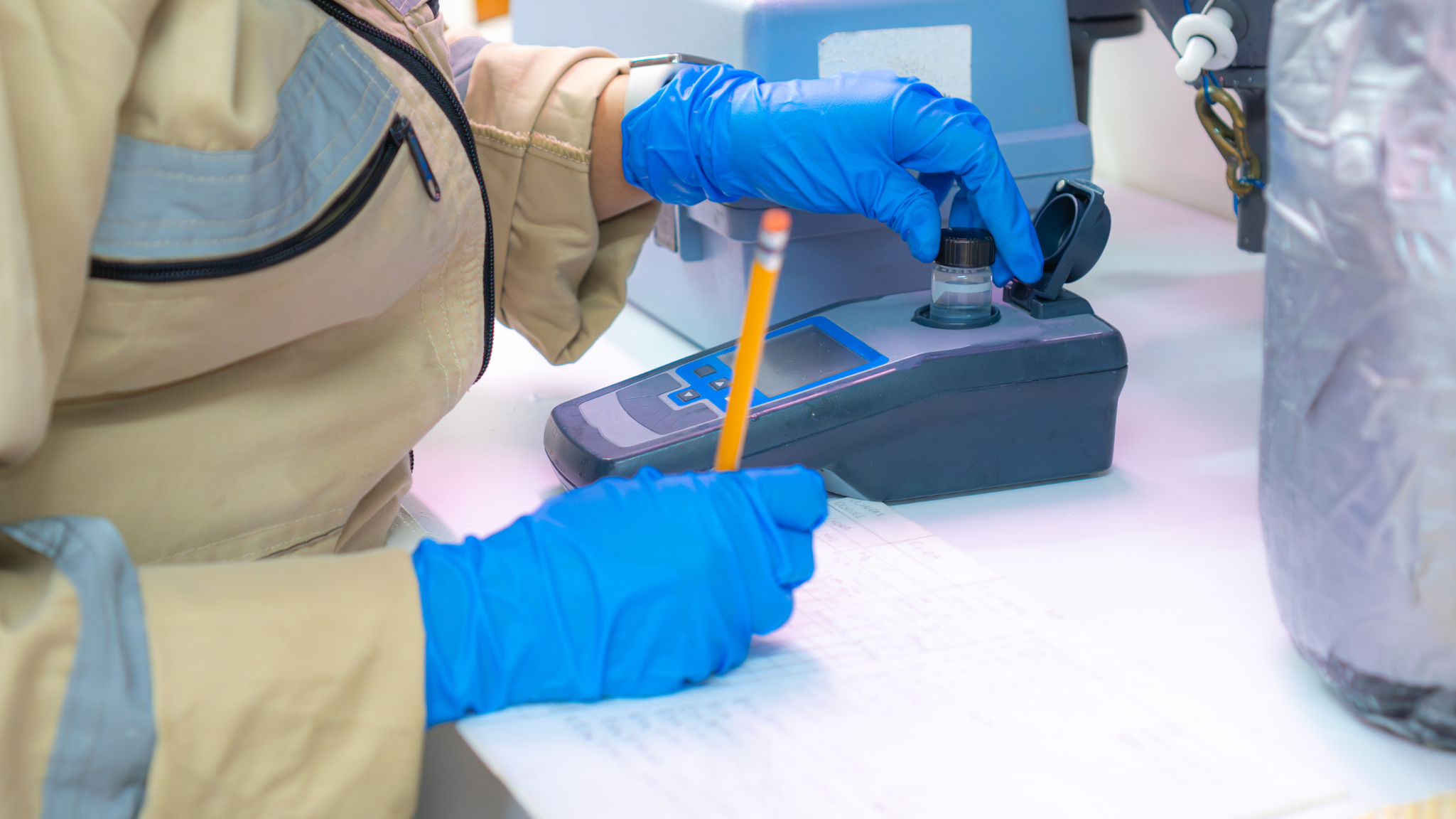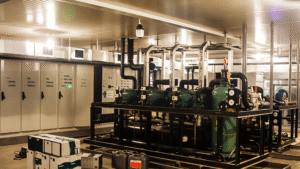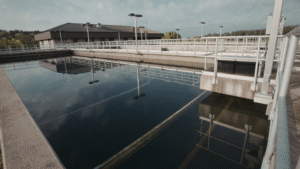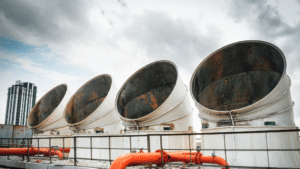When facility managers, engineers, or operators ask what is ppm in water, they are really asking how to measure and control the invisible substances dissolved in water that can make or break a system’s performance. PPM, short for parts per million, is a standard measurement used to determine the concentration of various substances in water. In cooling applications such as towers, chillers, and HVAC systems, understanding ppm is essential because it helps determine whether water is safe, efficient, and properly conditioned for industrial use.
PPM stands as a key benchmark for water quality across industries. By tracking the ppm value of dissolved solids, treatment chemicals, and other impurities, water treatment professionals can identify risks like scale buildup, corrosion, or biological growth before they cause costly downtime. In industrial water treatment, ppm is more than a number, it is a reflection of how well your system is protected and how reliably it will perform over time.
Understanding PPM and Its Role in Water Quality
PPM, or parts per million, is a unit used to measure the concentration of dissolved solids and other substances in water. In simple terms, one ppm equals one part of a substance mixed into one million parts of water. This makes ppm a practical way to quantify impurities, minerals, or treatment chemicals that are present at very low concentrations.
In cooling applications, ppm levels determine how efficiently equipment operates and how long it lasts. High concentrations of dissolved minerals or total dissolved solids (TDS) can accelerate scale buildup, while low ppm levels can indicate aggressive water that may corrode metal surfaces. Either extreme puts stress on critical assets such as heat exchangers and recirculating piping.
Understanding ppm also helps water treatment professionals identify trends in water quality. For example, consistent ppm measurements allow operators to evaluate whether chemical programs are effective and if adjustments are needed. In this sense, ppm not only measures what is in the water but also reflects the balance between chemistry, equipment protection, and operating costs.
How PPM Is Measured in Cooling Applications
Accurate ppm measurements are the foundation of effective industrial water treatment. In cooling towers and HVAC systems, operators rely on regular testing to ensure dissolved substances are within acceptable ranges. Because ppm levels can shift quickly with changes in feed water, load, or chemical dosing, routine testing is necessary to maintain water quality.
Several tools are commonly used to test water ppm. A TDS meter or conductivity meter provides a fast estimate of dissolved solids by measuring how well water conducts electricity. For more detailed analysis, ion specific electrodes or other electrochemical methods can isolate the concentration of specific ions, such as chlorides or calcium. These readings help determine whether the chemistry program is preventing scale buildup and corrosion.
Just as important as the tools are the procedures behind them. Operators must follow proper sampling procedures by collecting representative water samples, avoiding cross-contamination, and using calibrated instruments. To further improve accuracy, best practices call for technicians to perform duplicate measurements and compare results. Skipping these steps risks inaccurate readings that can lead to overfeeding or underfeeding water treatment chemicals.
Ultimately, ppm measurements provide operators with reliable data for adjusting chemical feed rates, monitoring system balance, and preventing costly downtime. Without accurate testing and quality control, even the best treatment programs may fall short.
Factors That Influence PPM Levels in Cooling Systems
Minerals and Dissolved Substances
A common source of elevated ppm is dissolved minerals such as calcium, magnesium, and sodium. When these accumulate, they can cause excess minerals to precipitate as scale, reducing heat transfer efficiency and driving up maintenance costs. Oxygen, chlorides, and water hardness also play major roles. Oxygen accelerates corrosion, while high chlorides attack stainless steel components. Hardness contributes to scale formation unless properly controlled with water treatment chemicals.
Gases and Organic Compounds
Other substances can also influence ppm. Carbon dioxide dissolves in water and forms carbonic acid, lowering pH and making the system more corrosive. Volatile organic compounds may be introduced from industrial environments, and in closed or semi-closed loops, chemical reactions can add to the load of dissolved substances.
High vs. Low PPM Risks
High ppm levels typically lead to scale buildup, fouling, and corrosion, while low ppm values may create aggressive water conditions that erode protective films on metal surfaces. Both scenarios shorten equipment life and increase the likelihood of system failures.
Changing Conditions
PPM values are not static. Seasonal shifts in source water, chemical dosage changes, and even system leaks can alter concentrations. Consistent monitoring ensures that ppm ranges remain within target levels, protecting both system performance and long-term reliability.
Interpreting PPM Values: Industry Guidelines
Understanding ppm values requires more than just taking a measurement. Once the numbers are recorded, operators need a framework for deciding whether those results fall within acceptable limits. That is where industry standards and guidelines come into play, offering reference points for both public health and industrial applications.
Industry Benchmarks and Safe Ranges
Different industries rely on defined ppm ranges to guide operations and safety. In cooling water systems, operators track ppm levels of dissolved solids, hardness, and treatment chemicals to balance efficiency and corrosion control. Excessively high ppm values often lead to scale deposits and fouling, while significantly lower ppm readings may indicate aggressive water that increases corrosion risks.
Public Health Standards
For potable water, organizations like the World Health Organization (WHO) and the Environmental Protection Agency (EPA) provide guidance. For example, WHO suggests limits on dissolved solids to avoid unpleasant taste, metallic taste, or health risks. The EPA also regulates ppm values for heavy metals and volatile organic compounds, ensuring that drinking water remains safe for public consumption.
Quality Control in Industrial Water Treatment
In industrial environments, ppm is equally tied to quality control measures. Facility managers and water treatment professionals must routinely monitor water ppm values to ensure compliance with local discharge permits and industry standards. Keeping ppm within recommended guidelines helps safeguard equipment, protect the environment, and reduce operating costs.
PPM in Cooling Applications: Practical Impacts
PPM values are not just abstract numbers. In cooling towers, chillers, and HVAC systems, they directly affect how efficiently water transfers heat, how long equipment lasts, and how much operators spend on maintenance costs. By connecting ppm results to real-world outcomes, water treatment professionals can better understand why routine monitoring is critical.
Impact on Scaling and Corrosion
High ppm ranges of minerals such as calcium and magnesium often lead to scale buildup. These deposits act as insulation, lowering heat transfer efficiency and forcing systems to use more energy. Conversely, when ppm values are too low, water becomes aggressive and corrodes metal components, weakening piping, exchangers, and other assets.
Connection to Water Treatment Chemicals
Maintaining ppm balance is also essential for optimizing water treatment chemicals. When ppm levels are outside the desired range, chemical feed rates may be ineffective, leading to wasted product or underprotection of assets. Accurate ppm control ensures chemical programs work as intended.
Role of Pretreatment and System Design
Tools like filtration systems, water softeners, and customized industrial water treatment programs help keep ppm values under control. Proper conditioning of feed water reduces the likelihood of excess solids and dissolved minerals entering the system, protecting long-term reliability.
At ETI, this process goes beyond off-the-shelf chemistry. By pairing ppm data with custom-blended dispersants, inhibitors, and scale control agents, operators can fine-tune protection for multi-metal systems common in industrial plants. This blending expertise allows facilities to manage diverse water conditions while minimizing both cost and environmental impact.
ETI’s Role in Supporting Water Treatment Professionals
Monitoring and managing ppm values in cooling systems requires more than just instruments, it requires the right chemistry and expertise behind them. At ETI, we focus on helping operators and engineers translate ppm readings into effective treatment strategies that extend system life, reduce operating costs, and maintain compliance.
Our cooling and boiler treatments are designed to control scale buildup, corrosion, and microbial activity by maintaining proper ppm ranges across a variety of systems. For facilities using reverse osmosis and related technologies, our membrane treatments help keep feed water clean and extend membrane performance.
We also provide ongoing education and skills development through the ETI Bootcamp and training programs, which give water treatment professionals hands-on experience with ppm measurement, system troubleshooting, and chemistry applications. To support distributors and industrial clients more broadly, our full suite of water treatment solutions ensures reliable, custom-blended chemistry tailored to facility needs in Pennsylvania, Ohio, and beyond.
By combining tailored chemistry with technical training, ETI helps water treatment professionals maintain accurate readings, ensure proper ppm control, and protect their cooling and boiler systems long term.
Why PPM Control Matters
Understanding what is ppm in water is essential for protecting cooling towers, boilers, and HVAC systems from scale, corrosion, and unnecessary costs. Accurate ppm monitoring allows facilities to safeguard equipment performance, reduce maintenance, and ensure compliance with industry standards.
Ready to improve your ppm control? Contact ETI today to connect with our team of experts and discover tailored chemical solutions that fit your system needs.
Frequently Asked Questions (FAQs)
What does parts per million (ppm) mean in water testing?
Parts per million (ppm) is a unit that shows how many million parts of water contain one ppm amount of a substance. For example, 1 ppm equals one part of a dissolved substance in one million units of water. This makes ppm useful for identifying other impurities such as minerals, salts, or treatment chemicals at very low concentrations. Understanding ppm helps determine whether water is closer to pure water or tap water with dissolved solids.
How does ppm affect water quality in cooling systems?
PPM levels directly influence how well equipment runs and how long it lasts. High readings may indicate scale-forming minerals or other impurities, while significantly lower ppm values can create aggressive water that corrodes system components. Both extremes increase maintenance costs. Accurate ppm tracking allows operators to balance conditions and maintain water quality over time.
Why are ppm measurements important in industrial water treatment?
PPM data guides chemical dosing, cycles of concentration, and blowdown decisions so systems avoid scale, corrosion, and biofouling. It supports regulatory compliance and quality assurance by documenting that water meets internal specifications and external limits. Trending ppm over time helps operators detect upsets early, optimize chemical spend, protect heat-transfer surfaces, and extend asset life.
What are best practices for accurate ppm measurements and sampling?
Reliable ppm measurements ensure that operators can take corrective action before scale, corrosion, or fouling occurs. Best practices include collecting water samples carefully to avoid sample contamination, using calibrated instruments, and sometimes repeating with duplicate measurements for confidence. Technicians often rely on electrochemical methods, such as conductivity or ion-specific electrodes, to ensure accurate readings.
How do you calculate or convert ppm in water analysis?
Operators use ppm calculation to quantify substances in water. To calculate ppm, divide the mass of the solute by the total mass of the solution, then multiply by one million. Instruments can also convert ppm into other units like mg/L. When testing, it is important to follow proper sampling procedures and prevent errors to keep results trustworthy.
What substances are usually measured in ppm tests?
Common targets include dissolved minerals, salts, and excess minerals that may cause scale. In drinking water, agencies such as the World Health Organization and the Environmental Protection Agency also monitor heavy metals, carbon monoxide, and volatile organic compounds because of potential health risks and unpleasant taste. In cooling water, operators mainly track dissolved solids, water treatment chemicals, and carbon dioxide to maintain stable operating conditions.





